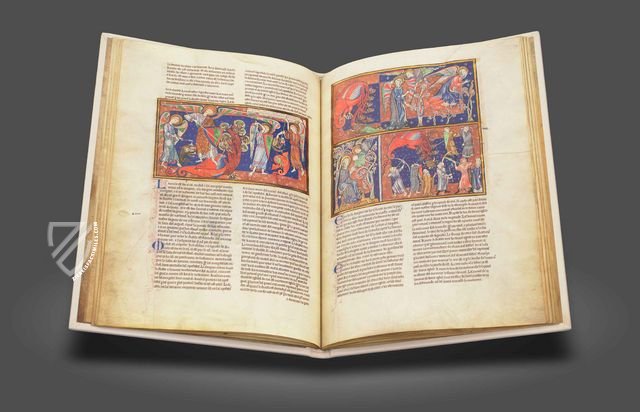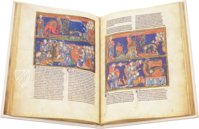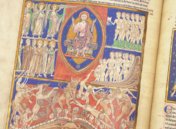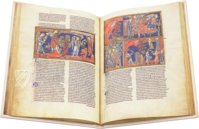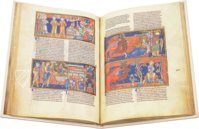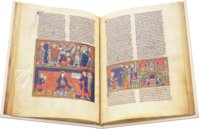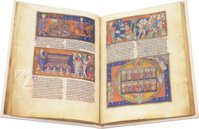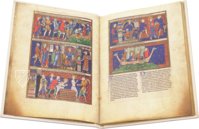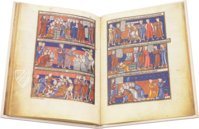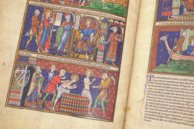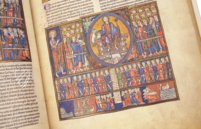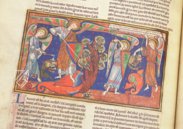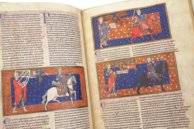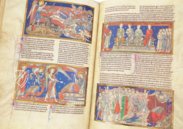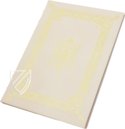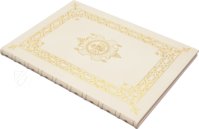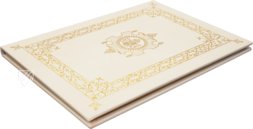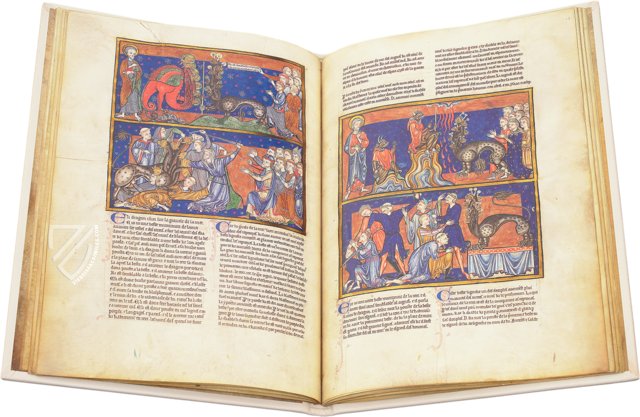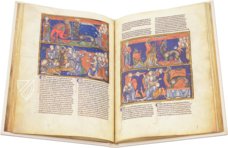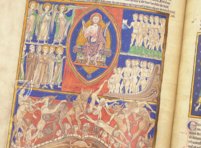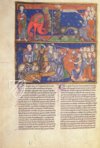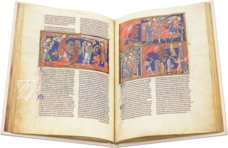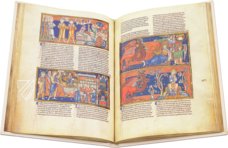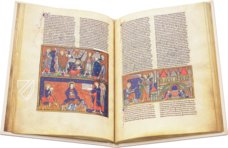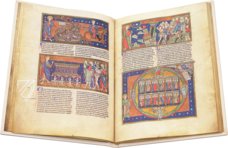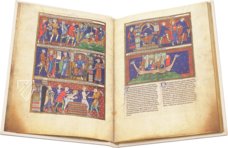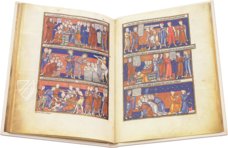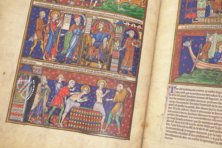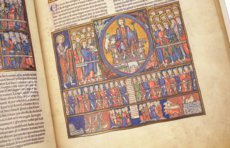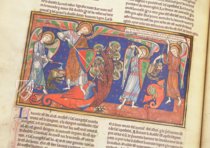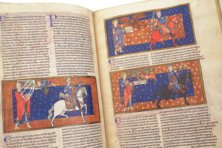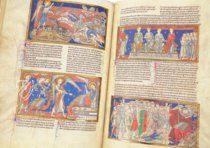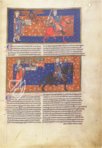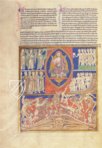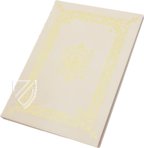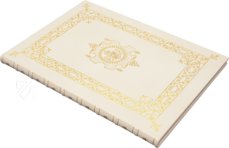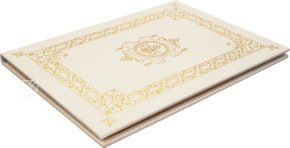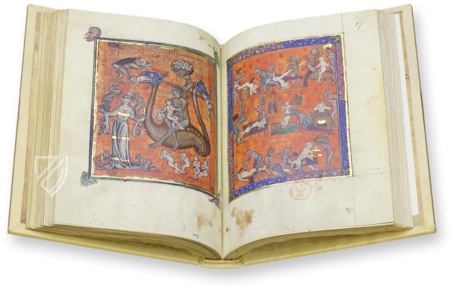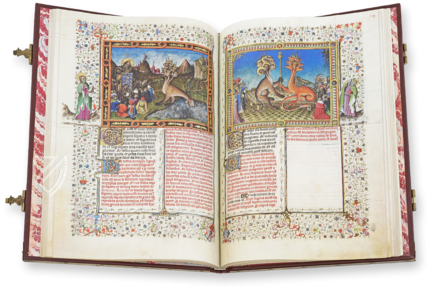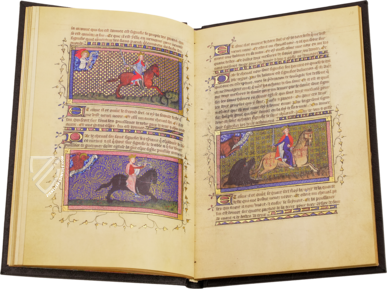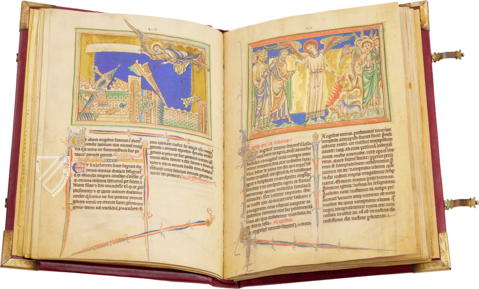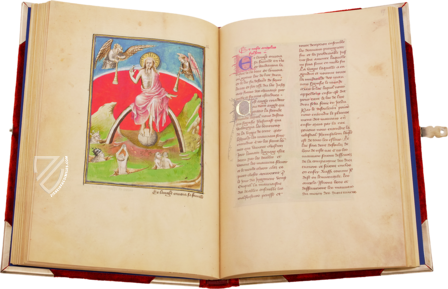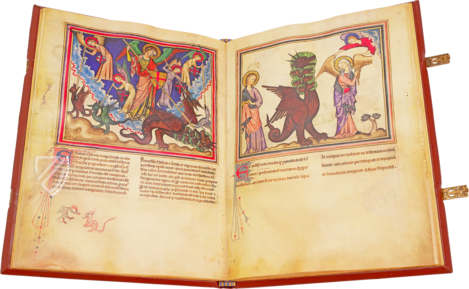Trinity Apocalypse
(1,000€ - 3,000€)
The Trinity Apocalypse is undoubtedly one of the most beautiful and precious surviving Apocalypse manuscripts and represents a major work from the exciting transitional period between Romanesque and Gothic book art. Two of the four illuminators involved were still adhering to a late English Romanesque style, while the other two were already working in the new French Gothic style. Together, they created a pictorial treasure of 71 magnificent miniatures, some of which are full-page, consisting of over 100 individual images in golden frames. The mesmerizing depictions of John of Patmos' end-time vision in the last book of the Bible shine in vibrant red, deep blue, and precious gold. This splendor was probably created for the unknown noblewoman who is repeatedly depicted at the edge of the miniatures. Particularly noteworthy, however, is the text layout, in which the French translation of the Book of Revelation is framed by a commentary on the life and work of its author, John of Patmos.
Trinity Apocalypse
The apocalypse manuscript named after its repository in Cambridge has come up with a pictorial treasure that is without equal. In over 100 pictures, the Revelation of John about the end of the world and the Day of Judgement is portrayed in wonderful colorful, richly detailed miniatures. The magnificent Trinity Apocalypse, which was created for an unknown commissioner, can be classified stylistically in the English artistic landscape, but simultaneously exhibits French-Gothic characteristics.
Wondrous Stories in Luminous Colors
Pandemonium rules the scenes: a black sun, a red moon, leaning and collapsing towers, flying waves, a horde of scared people. A single man standing on the left margin observes the wild events before a dark blue night’s sky in utter silence. The mysterious Revelation of John about the end of the world and the accompanying Day of Judgement with events that are equally joyous and frightening uses drastic and powerful imagery. The apocalypse was an especially popular theme for manuscripts in 13th century England. In the Trinity Apocalypse, which according to recent research originates from sometime after 1250, the artists succeed in creating a particularly impressive illustration of John’s tales. In 71 miniatures with over 100 individual pictures, the four illuminators, who can be differentiated from one another stylistically, portray approximately every passage of the book in a stylistic depiction. In doing so, the bizarre images are intensified with powerful colors, especially red and blue, and richly employed, often finely engraved gold. In a rectangular, gold framed image field, the mostly multi-figured scenes find their respective place. In doing so, not even the smallest fleck is free of decorative ornamentation.
A Masterwork of Anglo-Saxon Book Art
The commission of the apocalypse manuscript is unexplained. Stylistically, the artistic design, seconded by the distinctly linear style, can be placed in either England or Northern France. With regard to the artists, two can obviously be characterized as late English Romanesque, the other two are already Gothic and more likely French. The French language is also another peculiarity of the Trinity Apocalypse: the text is a specific French translation from Latin.
An exciting detail, that always bothers the scholarship, is the distinguished lady, which constantly resurfaces in some of the miniatures. Some want to see the English Queen Eleanor, the wife of King Henry III in her. The very hypothetical connection to her would make the splendid and highly artistic design of the manuscript plausible.
The design of the Trinity Apocalypse offers yet another innovation. On 11 pages of the precious manuscript, the text of Revelation of John is framed by the narration of his life story. This layout principle is based on gloss manuscripts of the time and can subsequently be observed more frequently in Apocalypse manuscripts. Thus, the magnificently colored and expressive miniatures and the vision they illuminate are closely linked to the life and work of their author, the prophet John of Patmos.
Codicology
- Alternative Titles
- Trinity College Apocalypse
Trinity-Apokalypse - Size / Format
- 64 pages / 43.5 × 32.0 cm
- Origin
- France
- Date
- 1242–1260
- Style
- Genre
- Language
- Script
- Textura rotunda
- Illustrations
- More than 100 individual pictures in 71 large-format miniatures, 9 of which are full-page, and numerous pen-flourish initials
- Patron
- Eleanore of Provence, the wife of King Henry III (?)
- Previous Owners
- Anne Sadlier
Ralph Brownrigg, Bishop of Exeter (1592–1649)
Trinity Apocalypse
Satan Imprisoned for 1,000 Years
John narrates on the left: “Then I saw an angel coming down from heaven, having the key to the bottomless pit and a great chain in his hand. He laid hold of the dragon, that serpent of old, who is the Devil and Satan, and bound him for a thousand years; and he cast him into the bottomless pit, and shut him up, and set a seal on him, so that he should deceive the nations no more till the thousand years were finished. But after these things he must be released for a little while.” (Rev. 20:1-3)
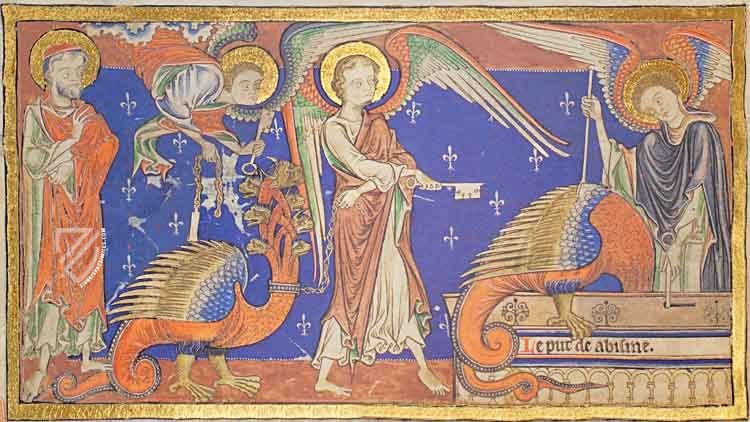
Trinity Apocalypse
The Lamb on Mount Zion
“And I looked and lo, a Lamb stood on Mount Zion, and with Him a hundred forty and four thousand, having His Father’s name written in their foreheads…And they sang, as it were, a new song before the throne, and before the four living beings and the elders; and no man could learn that song, except the hundred and forty and four thousand who were redeemed from the earth” (Rev. 14:1,3)
This grand three-quarter-page miniature depicts the multitudes of the faithful, the first to be saved. Brilliantly burnished gold attracts one’s attention to the empty throne surrounded by the Evangelist symbols. Christ has yet to appear, and the elders, depicted as kings, look and gesture to one another with anticipation. John, the narrator, appears in the left margin.
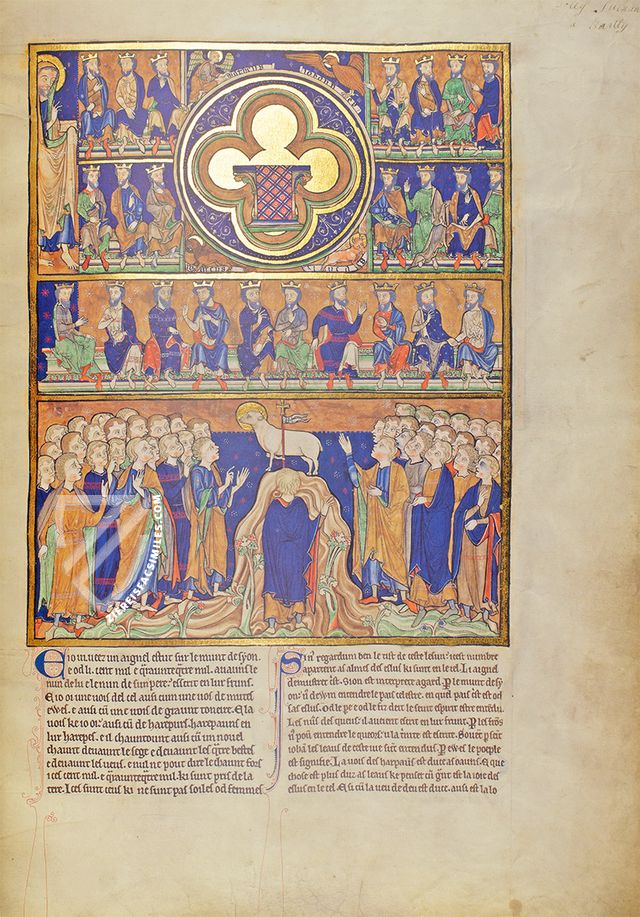
#1 Trinity-Apocalypse
Languages: English, German
(1,000€ - 3,000€)
- Treatises / Secular Books
- Apocalypses / Beatus
- Astronomy / Astrology
- Bestiaries
- Bibles / Gospels
- Chronicles / History / Law
- Geography / Maps
- Saints' Lives
- Islam / Oriental
- Judaism / Hebrew
- Single Leaf Collections
- Leonardo da Vinci
- Literature / Poetry
- Liturgical Manuscripts
- Medicine / Botany / Alchemy
- Music
- Mythology / Prophecies
- Psalters
- Other Religious Books
- Games / Hunting
- Private Devotion Books
- Other Genres
- Afghanistan
- Armenia
- Austria
- Belgium
- Belize
- Bosnia and Herzegovina
- China
- Colombia
- Costa Rica
- Croatia
- Cyprus
- Czech Republic
- Denmark
- Egypt
- El Salvador
- Ethiopia
- France
- Germany
- Greece
- Guatemala
- Honduras
- Hungary
- India
- Iran
- Iraq
- Israel
- Italy
- Japan
- Jordan
- Kazakhstan
- Kyrgyzstan
- Lebanon
- Liechtenstein
- Luxembourg
- Mexico
- Morocco
- Netherlands
- Palestine
- Panama
- Peru
- Poland
- Portugal
- Romania
- Russia
- Serbia
- Spain
- Sri Lanka
- Sweden
- Switzerland
- Syria
- Tajikistan
- Turkey
- Turkmenistan
- Ukraine
- United Kingdom
- United States
- Uzbekistan
- Vatican City
- A. Oosthoek, van Holkema & Warendorf
- Aboca Museum
- Ajuntament de Valencia
- Akademie Verlag
- Akademische Druck- u. Verlagsanstalt (ADEVA)
- Aldo Ausilio Editore - Bottega d’Erasmo
- Alecto Historical Editions
- Alkuin Verlag
- Almqvist & Wiksell
- Amilcare Pizzi
- Andreas & Andreas Verlagsbuchhandlung
- Archa 90
- Archiv Verlag
- Archivi Edizioni
- Arnold Verlag
- ARS
- Ars Magna
- ArtCodex
- AyN Ediciones
- Azimuth Editions
- Badenia Verlag
- Bärenreiter-Verlag
- Belser Verlag
- Belser Verlag / WK Wertkontor
- Benziger Verlag
- Bernardinum Wydawnictwo
- BiblioGemma
- Biblioteca Apostolica Vaticana (Vaticanstadt, Vaticanstadt)
- Bibliotheca Palatina Faksimile Verlag
- Bibliotheca Rara
- Boydell & Brewer
- Bramante Edizioni
- Bredius Genootschap
- Brepols Publishers
- British Library
- C. Weckesser
- Caixa Catalunya
- Canesi
- CAPSA, Ars Scriptoria
- Caratzas Brothers, Publishers
- Carus Verlag
- Casamassima Libri
- Centrum Cartographie Verlag GmbH
- Chavane Verlag
- Christian Brandstätter Verlag
- Circulo Cientifico
- Club Bibliófilo Versol
- Club du Livre
- CM Editores
- Collegium Graphicum
- Collezione Apocrifa Da Vinci
- Comissão Nacional para as Comemorações dos Descobrimentos Portugueses
- Coron Verlag
- Corvina
- CTHS
- D. S. Brewer
- Damon
- De Agostini/UTET
- De Nederlandsche Boekhandel
- De Schutter
- Deuschle & Stemmle
- Deutscher Verlag für Kunstwissenschaft
- DIAMM
- Droz
- E. Schreiber Graphische Kunstanstalten
- Ediciones Boreal
- Ediciones Grial
- Ediclube
- Edições Inapa
- Edilan
- Editalia
- Edition Deuschle
- Edition Georg Popp
- Edition Leipzig
- Edition Libri Illustri
- Editiones Reales Sitios S. L.
- Éditions de l'Oiseau Lyre
- Editions Medicina Rara
- Editorial Casariego
- Editorial Mintzoa
- Editrice Antenore
- Editrice Velar
- Edizioni Edison
- Egeria, S.L.
- Eikon Editores
- Electa
- Emery Walker Limited
- Enciclopèdia Catalana
- Eos-Verlag
- Ephesus Publishing
- Ernst Battenberg
- Eugrammia Press
- Extraordinary Editions
- Fackelverlag
- Facsimila Art & Edition
- Facsimile Editions Ltd.
- Facsimilia Art & Edition Ebert KG
- Faksimile Verlag
- Feuermann Verlag
- Folger Shakespeare Library
- Franco Cosimo Panini Editore
- Friedrich Wittig Verlag
- Fundación Hullera Vasco-Leonesa
- G. Braziller
- Gabriele Mazzotta Editore
- Gebr. Mann Verlag
- Gesellschaft für graphische Industrie
- Getty Research Institute
- Giovanni Domenico de Rossi
- Giunti Editore
- Graffiti
- Grafica European Center of Fine Arts
- Guido Pressler
- Guillermo Blazquez
- Gustav Kiepenheuer
- H. N. Abrams
- Harrassowitz
- Harvard University Press
- Helikon
- Hendrickson Publishers
- Henning Oppermann
- Herder Verlag
- Hes & De Graaf Publishers
- Hoepli
- Holbein-Verlag
- Houghton Library
- Hugo Schmidt Verlag
- Idion Verlag
- Il Bulino, edizioni d'arte
- ILte
- Imago
- Insel Verlag
- Insel-Verlag Anton Kippenberger
- Instituto de Estudios Altoaragoneses
- Instituto Nacional de Antropología e Historia
- Introligatornia Budnik Jerzy
- Istituto dell'Enciclopedia Italiana - Treccani
- Istituto Ellenico di Studi Bizantini e Postbizantini
- Istituto Geografico De Agostini
- Istituto Poligrafico e Zecca dello Stato
- Italarte Art Establishments
- Jan Thorbecke Verlag
- Johnson Reprint Corporation
- Josef Stocker
- Josef Stocker-Schmid
- Jugoslavija
- Karl W. Hiersemann
- Kasper Straube
- Kaydeda Ediciones
- Kindler Verlag / Coron Verlag
- Kodansha International Ltd.
- Konrad Kölbl Verlag
- Kurt Wolff Verlag
- La Liberia dello Stato
- La Linea Editrice
- La Meta Editore
- Lambert Schneider
- Landeskreditbank Baden-Württemberg
- Leo S. Olschki
- Les Incunables
- Liber Artis
- Library of Congress
- Libreria Musicale Italiana
- Lichtdruck
- Lito Immagine Editore
- Lumen Artis
- Lund Humphries
- M. Moleiro Editor
- Maison des Sciences de l'homme et de la société de Poitiers
- Manuscriptum
- Martinus Nijhoff
- Maruzen-Yushodo Co. Ltd.
- MASA
- Massada Publishers
- McGraw-Hill
- Metropolitan Museum of Art
- Militos
- Millennium Liber
- Müller & Schindler
- Nahar - Stavit
- Nahar and Steimatzky
- National Library of Wales
- Neri Pozza
- Nova Charta
- Oceanum Verlag
- Odeon
- Orbis Mediaevalis
- Orbis Pictus
- Österreichische Staatsdruckerei
- Oxford University Press
- Pageant Books
- Parzellers Buchverlag
- Patrimonio Ediciones
- Pattloch Verlag
- PIAF
- Pieper Verlag
- Plon-Nourrit et cie
- Poligrafiche Bolis
- Presses Universitaires de Strasbourg
- Prestel Verlag
- Princeton University Press
- Prisma Verlag
- Priuli & Verlucca, editori
- Pro Sport Verlag
- Propyläen Verlag
- Pytheas Books
- Quaternio Verlag Luzern
- Reales Sitios
- Recht-Verlag
- Reichert Verlag
- Reichsdruckerei
- Reprint Verlag
- Riehn & Reusch
- Roberto Vattori Editore
- Rosenkilde and Bagger
- Roxburghe Club
- Salerno Editrice
- Saltellus Press
- Sandoz
- Sarajevo Svjetlost
- Schöck ArtPrint Kft.
- Schulsinger Brothers
- Scolar Press
- Scrinium
- Scripta Maneant
- Scriptorium
- Shazar
- Siloé, arte y bibliofilia
- SISMEL - Edizioni del Galluzzo
- Sociedad Mexicana de Antropología
- Société des Bibliophiles & Iconophiles de Belgique
- Soncin Publishing
- Sorli Ediciones
- Stainer and Bell
- Studer
- Styria Verlag
- Sumptibus Pragopress
- Szegedi Tudomànyegyetem
- Taberna Libraria
- Tarshish Books
- Taschen
- Tempus Libri
- Testimonio Compañía Editorial
- Thames and Hudson
- The Clear Vue Publishing Partnership Limited
- The Facsimile Codex
- The Folio Society
- The Marquess of Normanby
- The Richard III and Yorkist History Trust
- Tip.Le.Co
- TouchArt
- TREC Publishing House
- TRI Publishing Co.
- Trident Editore
- Tuliba Collection
- Typis Regiae Officinae Polygraphicae
- Union Verlag Berlin
- Universidad de Granada
- University of California Press
- University of Chicago Press
- Urs Graf
- Vallecchi
- Van Wijnen
- VCH, Acta Humaniora
- VDI Verlag
- VEB Deutscher Verlag für Musik
- Verlag Anton Pustet / Andreas Verlag
- Verlag Bibliophile Drucke Josef Stocker
- Verlag der Münchner Drucke
- Verlag für Regionalgeschichte
- Verlag Styria
- Vicent Garcia Editores
- W. Turnowski Ltd.
- W. Turnowsky
- Waanders Printers
- Wiener Mechitharisten-Congregation (Wien, Österreich)
- Wissenschaftliche Buchgesellschaft
- Wissenschaftliche Verlagsgesellschaft
- Wydawnictwo Dolnoslaskie
- Xuntanza Editorial
- Zakład Narodowy
- Zollikofer AG

